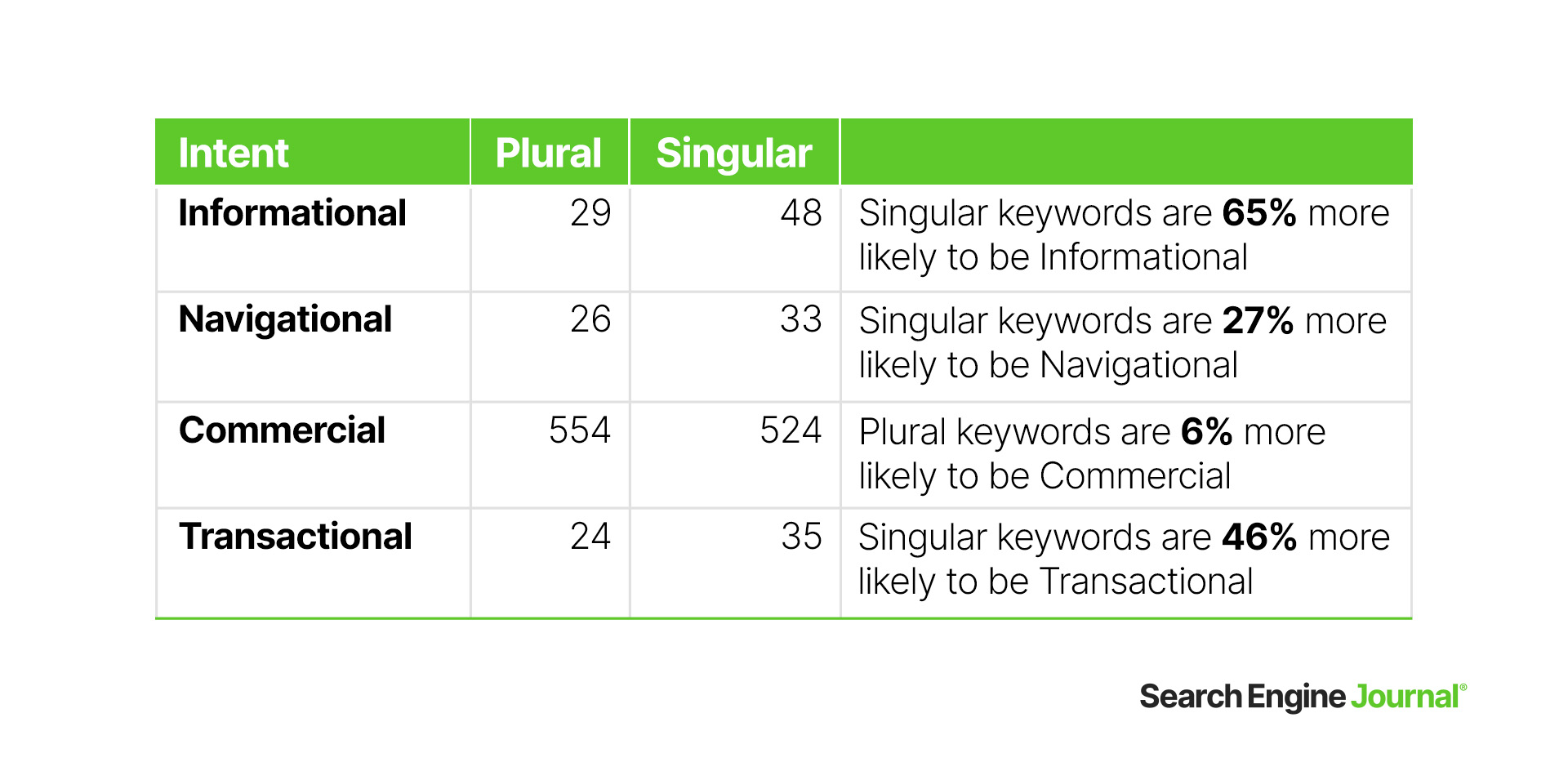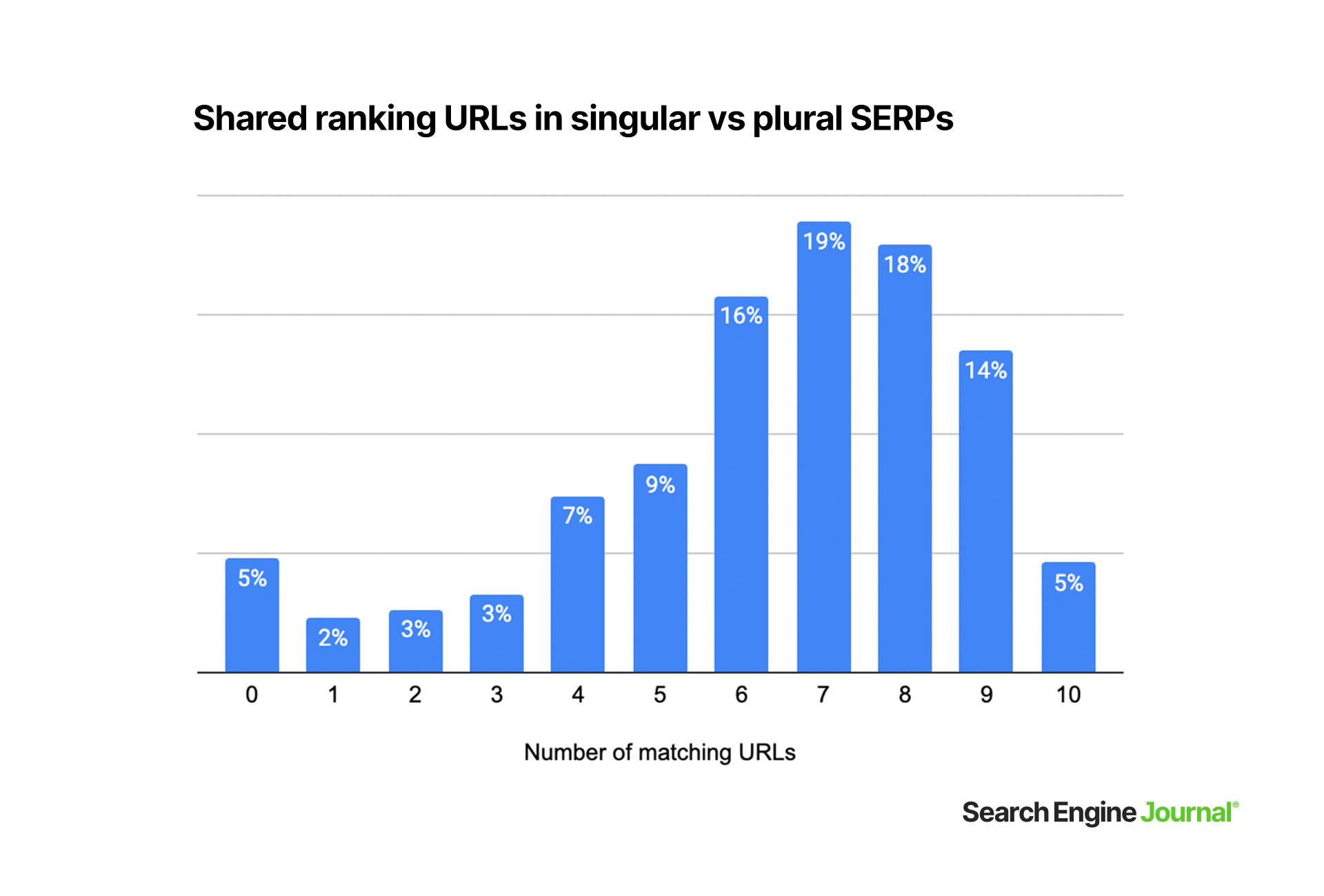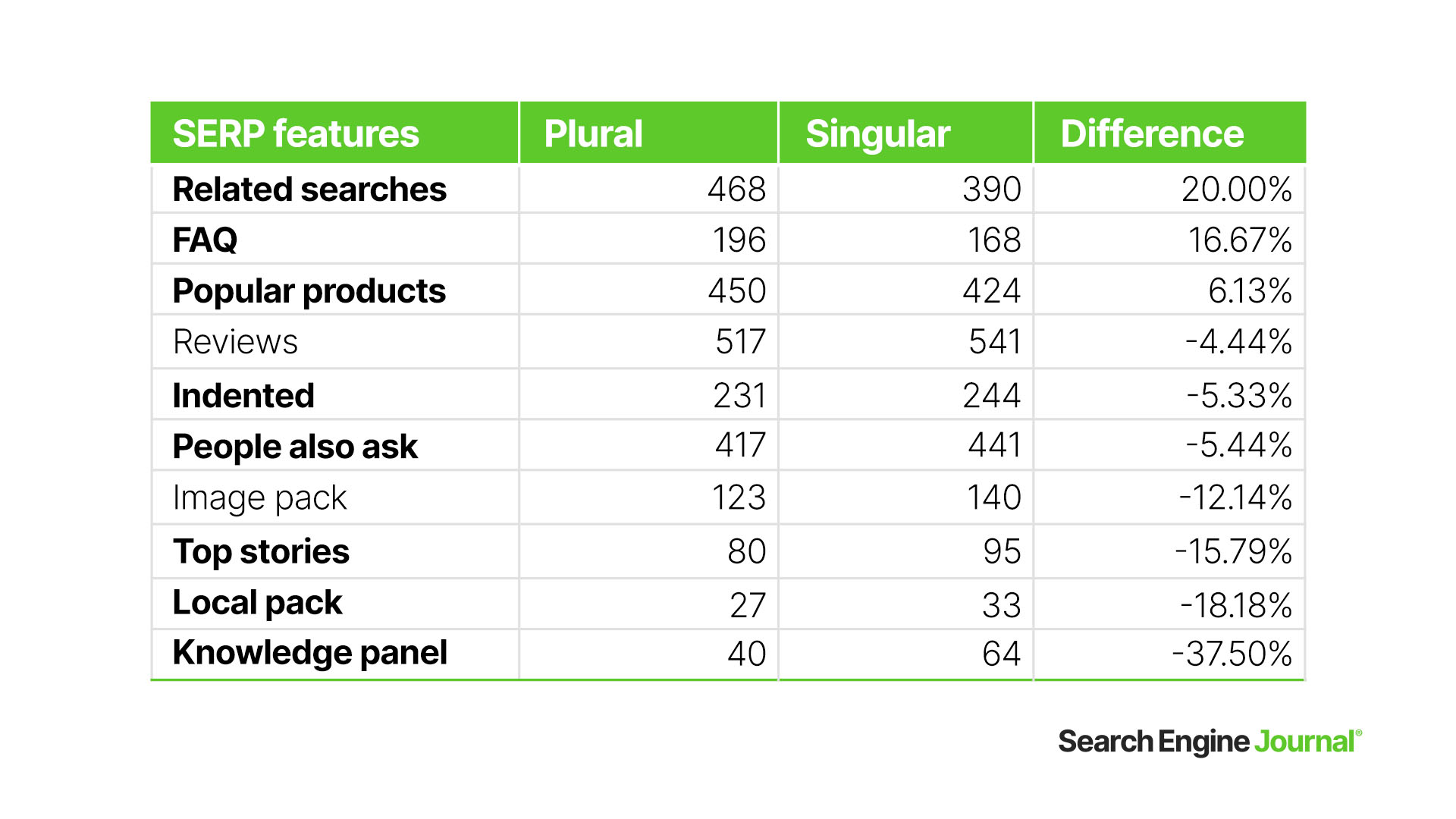When SEO pros are trying to optimize content, they have a choice to make: Do I choose the singular version or the plural one as my primary keyword? Can I rank for both versions of the keywords on the same page, or do I need a new one?
Having worked in SEO for over a decade, I’ve had to make this choice hundreds of times, and I’ve come to have an intuition about which option works best.
You can make this choice on a case-by-case basis, analyzing each keyword individually, but sometimes you need to make this choice in bulk.
If you’re modeling the content of a large ecommerce site, you’ll have to decide what version of your keyword gets used on product detail pages (PDPs) and category pages.
What We Know About Plural Keywords And Search Intent
During my career, I’ve noticed a pattern: Singular keywords are often informational, whereas plural keywords tend to be part of a buyer’s commercial research journey.
This is very obvious in SaaS, B2B, and other classic content marketing arenas.
As a Senior SEO Manager at Sanity, I know that a user searching for “headless CMS” is likely looking for an explanation, while someone searching for “headless CMSes” is looking for buying options.
If you’re shopping online and you’re trying to decide what product to buy, you’d be more likely to search for [men’s shirts] than [men’s shirt]. But if you search for [zara slim white shirt], your intent is likely transactional, and you’re ready to buy.
Google doesn’t always know this. If it thinks people are looking for multiple options or have yet to refine what they’re after, it will present a few potential product category pages.
It requires a very detailed search query to return a product detail page, such as specifying a brand and model, searching for a niche product, or tapping into a viral trend.
Navigational searches, where users are trying to reach a specific site or understand how to arrive at a physical location, are usually singular keywords. Brand names are usually singular, too – you’d never search for [Facebooks], you’d search for [Facebook].
From a programmatic SEO perspective, this means singular keywords suggest a more ambiguous intent, while plural keywords are more likely to be part of a user’s commercial research journey.
Tons of other SEO professionals share this intuition, and it has become standard best practice in ecommerce.
Singular keywords are typically used in product detail pages, while plural keywords tend to feature in category pages.
I decided to analyze the data to find out if our collective best practice was backed by the facts – and hopefully establish a data-led standard to help us choose which version of each keyword to use as the primary one for different types of pages, and whether or not we can rank for both.
It’s worth noting that some keywords are plural by nature. Things like “yellow laces for Dr. Martens boots” will never come as a singular, so those instances have been excluded from the study.
Analyzing The Top 1,000 Keywords On Amazon
Let me explain the methodology for this analysis.
I pulled the top 1,000 searched keywords on Amazon, identified if they were singular or plural, and paired them with their counterpart.
When the keywords didn’t have a singular or plural counterpart, I removed them from the database, leaving me with 607 keywords in total.
This shows that for 60% of the top keywords being used daily on Amazon, marketers have had to make the choice of optimizing for a singular or plural keyword. So making the right decision is crucial.
I then used Semrush data to extract the search intent, search engine results pages (SERP) features, and ranking URLs for each keyword on the Google results for desktop searches based in the US.
All measurements were done using Semrush, including SERP occurrences and search intent. (Full disclosure: I got the Semrush data free of charge. It pays to have connections.)
The data was analyzed on November 22 and again in June 2023 to give me my final results.
Analyzing Keyword Intent

The data shows that singular keywords dominate results for most search intent except for commercials.
Singular keywords are:
- 65% more likely to have informational intent.
- 46% more likely to have transactional intent.
- And 27% more likely to have navigational intent.
The only instance where plural keywords won out was commercial, and even then, there was only a 5% difference.
Could this suggest that singular keywords are more ambiguous?
It’s certainly a hypothesis the data seems to support, as singular keywords are 23% more likely than plural keywords to have more than one intent.
As users research and learn about their needs and the products that satisfy them, they can refine their searches further, but in the initial stages, search intent can be very murky.
Analyzing SERP Similarity

Fifty percent of the time, the SERPs for singular and plural versions of the keyword will share seven to nine URLs – and 5% of the time, those SERP results are the exact same because the intent on plural and singular keywords is often overlapping.
SEO professionals agonize over whether to use singular or plural keywords for URLs, but most of the time, we shouldn’t overthink it – you can expect to rank for both keywords on the same page.
However, another 5% of the time, there are no URLs in common. This can be because the plural and singular versions in those examples have completely different meanings.
For example, think about basketball (the game) and basketballs (the thing you need to play the game) – or switches (how lights work), and Switches (the Nintendo console). If you search for one, you’d be surprised to find results for the other.
Words that change their meaning when they change from singular to plural form are known as heteronyms or heteroglossia. While spelled the same in both forms, these words have different meanings in singular and plural forms. For example:
- “Leaves”: In its singular form, “leave” often refers to departing from a location. But in its plural form, “leaves,” it refers to more than one leaf from a tree or plant.
- “Winds”: In its singular form, ‘wind’ is the movement of air. In plural form, “winds” can refer to a variety of things, such as different types of air movements, or it can be used metaphorically.
However, this kind of semantic change is relatively rare in English, hence the low percentage.
Based on the data, the best practice would be to consider that singular and plural keywords have overlapping intent. This means your brand may position itself on both, in the same positions, or may see slight ranking differences between plural and singular keywords.
The data I analyzed in November 2022 looked a little different. Here, only 2% of searches had no URLs in common, and 50% of singular and plural keywords had 8 to 9 URLs in common.
Eight percent of SERPs for singular and plural keywords were identical, down to 5% in June. This could point at Google differentiating further the search intent in plural and singular searches, but it’s too early to tell.
As Google develops its AI offering, including its Search Generative Experience (SGE), and moves further towards a model where users can shop straight from their search, understanding the different intentions when there are minor keyword variations will be key.
Understanding intent at scale will become key for ecommerce merchants, and intent will take center stage.
Analyzing SERP Features
I’ve looked at how frequently SERP features appear in plural and singular searches. The results seem consistent with what we’ve seen so far, pointing at a broader range of search intents for singular keywords and a more commercially focused intent for plural keywords.
Knowledge Panels appear more often with the singular alternative, as do People Also Ask panels. This makes sense since those features align with an informational type of query.
Related Searches are the SERP feature with the greatest difference between plural and singular keywords; plural results were 12.85% more popular.
From my experience, users tend to refine their searches during commercial research as they learn about the product, and Google is trying to facilitate that journey.
Plural SERPs also prove more prevalent for Popular Products, further suggesting that plural keyword searches are more commonly associated with commercial intent.
Indented results, on the other hand, are more common in singular searches, potentially pointing at greater intent ambiguity. We can view indented results as Google not knowing the right page to show for a query and trying to offer alternative content.
What Does This Mean For Your Ecommerce SEO Strategy?
The data supports the SEO best practice: Plural keywords form part of the commercial research stage, while singular keywords have a more ambiguous intent and can be used for informational, navigational, or transactional purposes.
- The intent your page aims to satisfy should determine which version of the keyword to use.
- Category pages can clearly benefit from using plural keywords, as they are aimed at helping users find a product they will want to buy.
- Product pages should use singular keywords.
- Changing the grammatical number of our target keywords can completely change their meaning, so we can’t fully automate this decision yet.
- Most of the time, you can expect to rank for both singular and plural versions of your target keyword on the same page.
- Intent is complex, and it can evolve over time. There seems to be a trend of Google differentiating the SERPs for plural and singular keywords further over time which needs to be looked at.
More resources:
- 16 Best Keyword Research Tools For SEO
- How To Effectively Perform Keyword Research For Ecommerce
- Ecommerce Marketing: The Definitive Guide
Featured Image: Jo Panuwat D/Shutterstock

![How Plural Keywords Impact Search Intent For Ecommerce [Data Study]](https://www.searchenginejournal.com/wp-content/uploads/2023/08/search-intent-for-e-commerce-64e48e39a25f3-sej.png)



